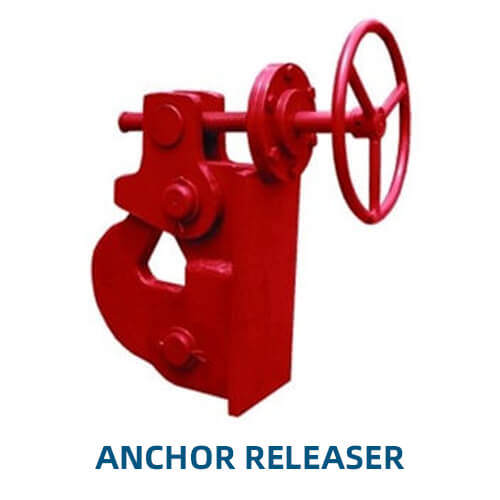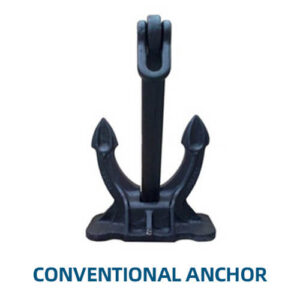Key Features of an Anchor Releaser:
- Design and Construction:
- Material: Anchor releasers are typically made from high-strength, corrosion-resistant materials like stainless steel or marine-grade aluminum. These materials are chosen to withstand the harsh marine environment and the significant forces involved in anchoring operations.
- Mechanical or Hydraulic Operation: Anchor releasers can be mechanically or hydraulically operated, depending on the design and the specific application. Hydraulic systems offer more precise control and can handle larger anchors, while mechanical systems are simpler and may be preferred for smaller vessels.
- Release Mechanism: The release mechanism is a critical component, designed to hold the anchor securely in place until the release is triggered. This mechanism may include a locking pin, lever, or hydraulic actuator that is activated by the crew.
- Functionality:
- Controlled Release: The primary function of an anchor releaser is to enable the controlled release of the anchor, allowing it to drop into the water when needed. This control is vital in ensuring that the anchor is deployed safely and that the vessel remains stable during the process.
- Emergency Deployment: In emergency situations, such as a sudden loss of power or need to stop the vessel immediately, the anchor releaser allows for rapid deployment of the anchor to secure the vessel and prevent it from drifting.
- Precision Placement: For operations that require precise anchor placement, such as offshore drilling or construction, the anchor releaser allows for accurate positioning, ensuring the anchor is deployed at the correct moment and location.
- Types of Anchor Releasers:
- Manual Anchor Releasers: These are simple devices operated by the crew, often involving a lever or pin that is manually pulled to release the anchor. They are commonly used on smaller vessels where simplicity and ease of use are priorities.
- Hydraulic Anchor Releasers: Hydraulic systems offer greater control and are used on larger vessels where the anchor size and weight require more powerful mechanisms. Hydraulic releasers are often integrated with the vessel’s overall anchoring and mooring system for automated or remote operation.
- Quick-Release Systems: These are specialized anchor releasers designed for emergency situations, allowing for rapid anchor deployment with minimal crew intervention. They are often found on ships where fast response times are critical.
- Applications:
- Commercial Shipping: In large commercial vessels, anchor releasers are crucial for safe and efficient anchoring, particularly in busy ports or emergency situations.
- Naval and Military Vessels: Military ships use anchor releasers that meet strict standards for reliability and durability, ensuring the vessel can anchor quickly under various operational conditions.
- Offshore Operations: In offshore drilling, construction, and supply vessels, anchor releasers are essential for precise anchor placement, which is critical for maintaining the stability and positioning of the vessel or platform.
- Yachts and Recreational Boats: Smaller vessels may use simpler anchor releasers to improve the ease and safety of anchoring during recreational activities.
- Performance and Benefits:
- Safety: Anchor releasers enhance the safety of anchoring operations by providing a reliable and controlled method for deploying the anchor, reducing the risk of accidents or equipment failure.
- Efficiency: The ability to release the anchor quickly and accurately improves operational efficiency, particularly in situations where time is critical.
- Flexibility: Anchor releasers offer flexibility in anchor deployment, allowing for both rapid emergency release and controlled, precise placement.
- Maintenance and Care:
- Regular Inspection: The anchor releaser should be regularly inspected for signs of wear, corrosion, or damage. Ensuring that the release mechanism is in good working order is crucial for safe operation.
- Lubrication: Moving parts, especially in mechanical systems, should be kept well-lubricated to ensure smooth operation. Hydraulic systems should also be checked for fluid levels and leaks.
- Testing: Periodic testing of the anchor releaser is important to verify that it functions correctly, particularly before critical operations or long voyages.
- Safety Considerations:
- Training: Crew members should be trained in the proper use of the anchor releaser, including emergency procedures. Understanding how to operate the releaser safely can prevent accidents during anchor deployment.
- Emergency Protocols: Ensure that there are clear protocols in place for using the anchor releaser in an emergency. These protocols should be regularly reviewed and practiced by the crew.
- Proper Sizing and Compatibility: The anchor releaser must be compatible with the size and type of anchor used on the vessel. Using an improperly sized releaser can lead to equipment failure or unsafe anchoring.
Advantages of an Anchor Releaser:
- Enhanced Safety: By allowing for controlled anchor release, the device reduces the risk of accidents and equipment damage during anchoring.
- Rapid Deployment: In emergencies, the anchor releaser enables quick and efficient deployment of the anchor, helping to secure the vessel immediately.
- Improved Precision: In operations requiring exact anchor placement, such as offshore construction, the releaser ensures accurate deployment.
Considerations for Anchor Releasers:
- Complexity: Hydraulic systems, while offering greater control, are more complex and require regular maintenance to ensure reliability.
- Cost: High-quality anchor releasers, particularly those designed for larger vessels or specific applications, can be expensive but are justified by the safety and efficiency benefits.
- Installation: Proper installation by qualified personnel is essential to ensure the anchor releaser functions correctly and safely.
Anchor releasers are essential tools in marine operations, providing the ability to deploy anchors safely, efficiently, and accurately. Their role in enhancing the safety and effectiveness of anchoring systems makes them a valuable component in both commercial and recreational maritime activities.






